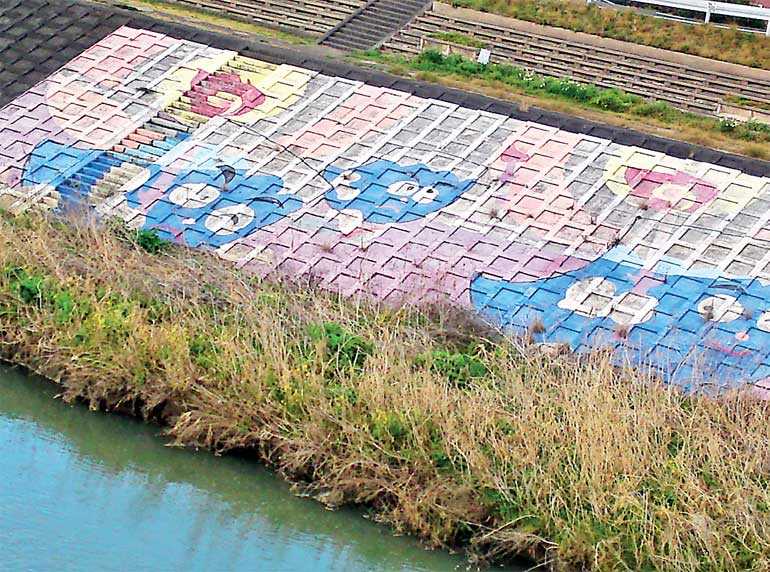Monday Apr 21, 2025
Monday Apr 21, 2025
Friday, 6 September 2019 00:00 - - {{hitsCtrl.values.hits}}

FUKUROI CITY, Japan (Reuters): Japan is one of the most vulnerable countries in the world to earthquakes, typhoons and tsunamis and organisers of next month’s rugby World Cup hope their best-laid plans are not thrown into disarray by a natural disaster. “We are planning right through from what happens if a team hotel is lost, what happens if a training venue is lost, through to what happens if one or more match venues are lost,” said Alan Gilpin, the tournament director of the event, in which 20 national teams battle for the title of world champion.
“Where do you relocate matches to, what are the time frames, how does that affect transport, planning, moving teams around? We are working through all those scenarios.” Japan experiences an average of 1,500 earthquakes a year, although few cause any damage, let alone loss of life. But the Kobe earthquake in 1995 killed more than 6,400 people and caused an estimated $100 billion (81.45 billion pounds) in damage.
In March 2011, a massive earthquake and tsunami devastated the east coast, killing almost 18,000 and triggering a meltdown at the Fukushima nuclear power plant. The eastern region is still trying to rebuild and the scars of the disaster remain visible. Just last year, the biggest storm in 25 years battered parts of Japan’s west coast, including the cities of Kobe and Osaka, both of which will host World Cup games.
Organisers have said they expect some 400,000 rugby fans to travel to Japan for the tournament, which takes place in 12 locations over seven weeks. The final is scheduled for Nov. 3 in Yokohama.
One of the hosts - Fukuroi City, more than 200 km (125 miles) south of Tokyo - is well aware of the risks and has measures in place to try to safeguard its citizens and visiting rugby fans.
“Fukuroi has a 70% chance of facing a large earthquake in the next 30 years,” the city’s assistant manager of risk management, Hiroaki Nagai, told Reuters. “That might be today or even a second after this.”
The city built a 5.3 km (3.3 mile) sea wall that is 12 metres (yards) high to protect the coastline from any potential tsunami following the 2011 disaster. “About 3,000 people live in the area where a tsunami would reach,” says Nagai. “We constructed this to save the people’s lives and to protect their property.”
Fukuroi City will host four games at the Shizuoka Stadium, including Ireland versus Japan and South Africa’s clash with Italy. The stadium hosted the 2002 soccer World Cup quarterfinal between England and Brazil and is more than 10 km from the coast, far enough inland to avoid the impact of a strong tsunami.
Fukuroi City authorities have built 73 evacuation centres in vulnerable areas of the municipality because much of the area is flat with little natural high ground.
There are evacuation signposts written in English and, reflecting a large local Brazilian population, in Portuguese as well.
More generally, Japan’s M i n i s t r y o f L a n d , Infrastructure, Transport and Tourism has disaster prevent websites in English, Korean and Chinese and the Japanese Meteorological Agency and the national broadcaster provide information via smartphone applications on disasters in English and other languages. The people of Fukuroi City are well practiced at evacuating. Once a week, for example, the 88 children attending Asaba Nursey School, take part in a drill. The children, aged one to six, wear a life vest and protective headgear and run to an evacuation tower just 100 metres (yards) from the school.
Should disaster strike, local people will help visitors, Nagai said.
“The Fukuroi government and the local people are willing to support you,” he said. “If you follow the evacuation process, we are sure that lives can be saved.”
Discover Kapruka, the leading online shopping platform in Sri Lanka, where you can conveniently send Gifts and Flowers to your loved ones for any event including Valentine ’s Day. Explore a wide range of popular Shopping Categories on Kapruka, including Toys, Groceries, Electronics, Birthday Cakes, Fruits, Chocolates, Flower Bouquets, Clothing, Watches, Lingerie, Gift Sets and Jewellery. Also if you’re interested in selling with Kapruka, Partner Central by Kapruka is the best solution to start with. Moreover, through Kapruka Global Shop, you can also enjoy the convenience of purchasing products from renowned platforms like Amazon and eBay and have them delivered to Sri Lanka.
Discover Kapruka, the leading online shopping platform in Sri Lanka, where you can conveniently send Gifts and Flowers to your loved ones for any event including Valentine ’s Day. Explore a wide range of popular Shopping Categories on Kapruka, including Toys, Groceries, Electronics, Birthday Cakes, Fruits, Chocolates, Flower Bouquets, Clothing, Watches, Lingerie, Gift Sets and Jewellery. Also if you’re interested in selling with Kapruka, Partner Central by Kapruka is the best solution to start with. Moreover, through Kapruka Global Shop, you can also enjoy the convenience of purchasing products from renowned platforms like Amazon and eBay and have them delivered to Sri Lanka.